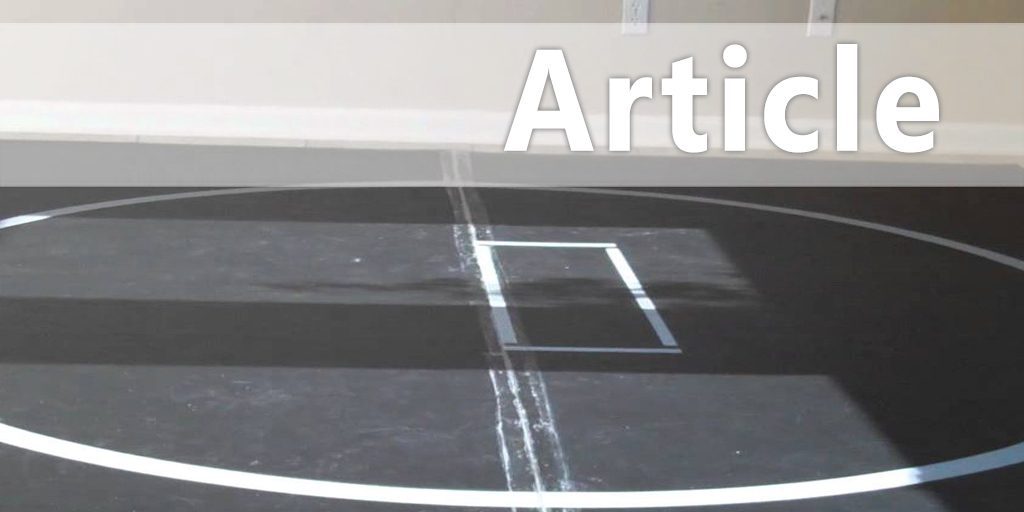| Specialized Wrestling Workouts
Originally Published in - The Wrestling Drill Book - Human Kinetics
The typical wrestling workout session involves spending about 50 percent of the time in the neutral position perfecting takedown skills. This is a smart workout approach because of the great importance takedown superiority has for winning matches. Next, both bottom and top mat wrestling would be equally divided for the purpose of polishing escape or reversal and ride or pinning combination skills. Likewise, for a change of pace you will sometimes want to incorporate workouts that add variation to the traditional wrestling session. Chain wrestling, situation wrestling, round-robin wrestling, and blindfold wrestling are excellent alternatives described in the following pages. Chain Wrestling Too often in contemporary scholastic matches, the bottom wrestler will attempt to escape or reverse his opponent by using only one or two moves. If they don't work, his opponent ultimately ends up riding him. We seem to have forgotten a lost art - chain wrestling, a fast-paced bottom maneuver and top countermaneuver wrestling activity. After perfecting the moves and countermoves that follow, you can incorporate chain wrestling. The most common chain wrestling skills include the following multiple moves: Standard Chain Wrestling Workout Step 1: Sit-out to turn-in (bottom wrestler) Step 2: Sit-out to turn-out (bottom wrestler) Step 3: Switch (bottom wrestler) Step 4: Side roll (bottom wrestler) Step 5: Granby roll (bottom wrestler) Step 6: Stand-up (bottom wrestler) Wrestlers repeat this chain wrestling process as many times as you instruct (usually three to five cycles) with wrestler WI on the bottom. Then wrestler W2 would assume the bottom position, repeating the cycle the same number of times. Of course, you may develop variations to this chain wrestling format to suit your particular mat wrestling concerns. No matter how you plan your chain wrestling activity, the key purpose of the workout is to train the bottom wrestler not to stop after one or two moves. Another benefit of chain wrestling is that it teaches the top wrestler how to follow moves performed by the bottom wrestler. Likewise, it is a superb conditioning tool for workout sessions. You may even want to create a practice competition out of chain wrestling, timing the wrestlers to see which pair is fastest in completing the cycles. In recent decades, coaches have placed so much emphasis on takedowns that many have ignored the importance of moving on the bottom. Chain wrestling is a snappy workout activity that doesn't take much practice time and leads to improved mat wrestling. Situation Wrestling Situation wrestling is usually incorporated during the season. It is much like a regular workout session with one exception: The wrestlers are placed in various wrestling positions and begin wrestling from that point. As with typical wrestling workouts, periodically stop the wrestlers to demonstrate what they are doing wrong. There is a twofold purpose for including situation wrestling in daily practice sessions. First, you can use the strategy to work on new moves and to demonstrate how they should be performed during real wrestling situations. The second rationale for adding situation wrestling to practice plans involves the scouting phase of coaching. While scouting rival teams, the coach often observes certain moves that members of those squads use the most to score points. Wisely, the coach will place his wrestlers in those various move situations, having them counter the maneuvers in preparation for an upcoming dual meet or tournament. This wrestling strategy has been very successful over the years. Let's now consider two examples of situation wrestling - one to perfect new moves and the other to prepare for competition. Drilling a New Move The coach has just completed demonstrating the standing suicide switch reversal maneuver. At this point, the wrestlers perform the maneuver in the following manner:
After the wrestlers passively perform the move, the coach then places the wrestlers in the standing position and blows the whistle. With the top wrestler resisting fully, the bottom wrestler is given 15 seconds to complete the standing suicide switch. This is an all-out burst of wrestling effort by both wrestlers, with the coach periodically stopping the action to correct mistakes. When scouting the next opponent in a dual meet, the coach learns that the majority of wrestlers are very proficient at scoring double-leg takedowns. At practices leading up to the meet, the coach places the wrestlers in the neutral position. He instructs the attacking team members to deeply penetrate the opponents' defense, clamping their hands around the knees. On the whistle, the wrestlers defend themselves from the double-leg take-down counter, performing the following steps: Step 1: Crossface and sprawl Step 2: Whizzer and hip into opponent with whipping action Step 3: Force head down with free hand and push away This process continues until all practice partners have demonstrated the ability to properly counter the double-leg takedown. Situation wrestling will greatly enhance the skill level of all team members. Do not fail to make it part of your workout repertoire. Round-Robin Wrestling Round-robin wrestling is another action-packed workout. One advantage to round-robin wrestling is that the entire squad participates simultaneously. This routine involves the following procedure:
As you can visualize, round-robin wrestling consists of a very invigorating workout. The prime objectives are quite obvious: conditioning and further skill development. Following are some interesting variations that make this alternative wrestling strategy even more intriguing:
Of course, the creative coach may come up with even more novel approaches to enhance the round-robin experience. That's fantastic! Just remember to follow the previous guidelines, and it will be a productive substitute to the traditional workout scheme. Blindfold Wrestling Blindfold wrestling is another beneficial innovation for practices. The workout session is the same as usual, with one exception: The wrestlers are blindfolded. Though the wrestlers may be a little hesitant at first, they will soon realize that they really don't need their eyes in order to wrestle. Proper body positioning in wrestling is really a matter of feel, a sense of where you are or should be. Of course, such mat sense can be achieved only via years of practice. Note that it is important for the veteran wrestlers on the team to assist the younger wrestlers performing this specialized workout. Blindfold wrestling is one workout medium a coach can implement to achieve this wrestler-oriented goal. The only props needed are blindfolds cut from old bed sheets or bandannas. The following are a few basic guidelines for incorporating blindfold wrestling into your daily practices:
Be sure to take safety measures into consideration. First, during blindfold wrestling, there should be fewer wrestling pairs competing on the mats than usual. Second, those wrestlers waiting to work out must act as spotters, stopping their peers as they are about to go out of bounds. Third, these wrestlers should also lead the blindfolded wrestlers back to their starting positions and restart them. Finally, the coach's whistle must be the signal for all blindfolded wrestlers to stop immediately. During a blindfold wrestling session, the coach should stop the wrestlers and ask them what they are experiencing. The most common response will be that the wrestlers found themselves reacting to their opponents' movements rather than thinking about what to do. You will learn by watching whether your wrestlers are responding properly and swiftly, relying primarily on their sense of touch rather than sight. As we all know, this tactile (or mat) sense is a characteristic observed in all champion wrestlers. Chain wrestling, situation wrestling, round-robin wrestling, and blindfold wrestling have a great deal to add to a comprehensive wrestling program. These workout alternatives increase stamina, develop continuous mat (or ground) wrestling abilities, improve takedown skills, promote mat sense, and further prepare the wrestlers for competition.
|






